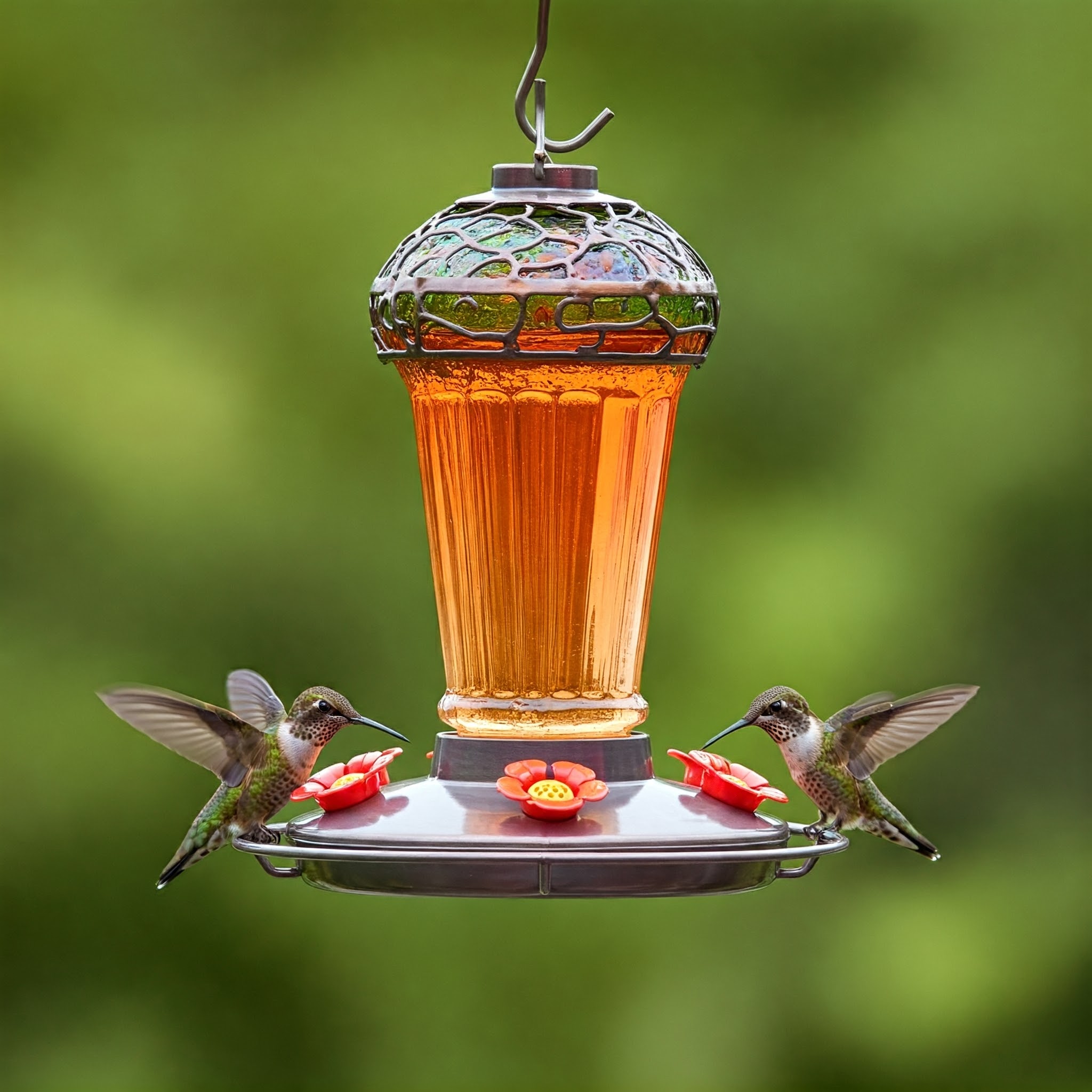Hummingbirds are among nature’s most fascinating creatures. With their iridescent feathers, lightning-fast wings, and ability to hover mid-air, they bring a unique charm to any garden. Watching them flit from flower to feeder is a rewarding experience that can be made even more delightful by incorporating decorative hummingbird feeders into your outdoor space.
Today’s hummingbird feeders do more than provide nourishment—they double as exquisite pieces of garden art. Among the most popular choices are ceramic hummingbird feeders and mosaic hummingbird feeders, which combine functionality with aesthetic appeal. These feeders not only support your efforts to attract hummingbirds but also serve as a statement piece, transforming your garden into a visual paradise.
Why Decorative Hummingbird Feeders Are a Must-Have
When choosing a hummingbird feeder, functionality is important, but why stop there? Decorative feeders like ceramic and mosaic styles take it a step further, allowing you to blend form and function. Here’s why they are so popular:
1. Attract More Hummingbirds to Your Garden
Decorative feeders stand out against the greenery of your garden, drawing the attention of hummingbirds more effectively than plain feeders. Their vibrant colors and unique designs mimic the bright flowers that hummingbirds naturally seek, making them irresistible.
2. Enhance Your Outdoor Decor
Hummingbird feeders don’t have to be an afterthought. With the right design, they become an integral part of your garden’s decor. Ceramic and mosaic feeders bring elegance and artistry, elevating your outdoor space into a sanctuary for both humans and birds.
3. Support Wildlife Sustainably
By providing a reliable source of nectar, decorative feeders support local hummingbird populations, especially during migration or in areas with limited natural nectar sources. Choosing durable, eco-friendly materials like ceramic and mosaic glass ensures that your feeder is both beautiful and sustainable.
Ceramic Hummingbird Feeders: Timeless Elegance and Practical Benefits
Ceramic hummingbird feeders are a favorite for gardeners looking to balance durability and beauty. They come in a wide range of styles, from rustic hand-thrown pottery to sleek, modern designs.
Features of Ceramic Feeders
- Artistic Designs for Every Taste
Whether your garden has a rustic charm or a contemporary vibe, ceramic feeders come in styles to match. Many feature intricate patterns, natural hues, or hand-painted designs inspired by flowers and wildlife. - Weather Resistance
Ceramic feeders are built to last. They resist cracking, fading, and damage from the elements, making them a reliable choice for outdoor use. - Ease of Maintenance
The smooth surfaces of ceramic feeders make them easy to clean, which is crucial for keeping the nectar fresh and safe for hummingbirds. - Eco-Friendly Material
Ceramics are often made from natural clay and glazed with non-toxic finishes, making them a sustainable choice for environmentally conscious gardeners.
Mosaic Hummingbird Feeders: Where Light and Color Dance
If you want a feeder that doubles as a work of art, look no further than mosaic hummingbird feeders. These feeders are crafted by arranging tiny pieces of glass, tile, or other materials into intricate patterns, resulting in a dazzling display of light and color.
What Makes Mosaic Feeders Special?
- Vibrant, Eye-Catching Designs
Mosaic feeders often feature bold patterns and colors that sparkle in the sunlight, creating a mesmerizing effect. Their reflective surfaces catch a hummingbird’s attention from afar, making them a functional yet decorative focal point in your garden. - Durability for Outdoor Conditions
Mosaics are crafted with materials like tempered glass or weather-resistant adhesives, ensuring they hold up to the elements without losing their luster. - Customization Options
Mosaic feeders are highly customizable, allowing you to choose colors and designs that reflect your personality or complement your garden’s theme. - Light Play for Added Beauty
The way mosaic tiles shimmer in the sunlight adds a magical touch, turning your feeder into a living piece of art.
How to Create a Hummingbird Haven
Adding a decorative feeder is only the beginning. To truly make your garden a hummingbird sanctuary, you need to consider placement, maintenance, and other complementary elements.
1. Choose the Right Location
- Accessibility: Place your feeder where it’s easy for hummingbirds to spot and access, such as near flowering plants or in a shaded area.
- Visibility: Make sure you can see the feeder from a window or patio to enjoy the sight of these fascinating creatures.
- Safety: Hang feeders at least 4–6 feet off the ground to keep them safe from predators like cats.
2. Offer Homemade Nectar
Skip the store-bought nectar and opt for a simple homemade recipe:
- Mix 1 part white sugar with 4 parts water.
- Boil the mixture to dissolve the sugar, let it cool, and fill your feeder.
- Avoid red dye or additives, as they can harm hummingbirds.
3. Keep Feeders Clean
Dirty feeders can harbor mold and bacteria that are harmful to hummingbirds. Follow these tips for maintenance:
- Rinse and refill every 2–3 days in warm weather (or weekly in cooler temperatures).
- Use a mild vinegar solution or hot water to clean the feeder thoroughly.
4. Complement Feeders with Native Plants
Plant nectar-rich flowers like salvia, trumpet vine, bee balm, and columbine to provide additional food sources for hummingbirds. Native plants are particularly effective at attracting local bird species.
Turning Feeders into Garden Art
Your hummingbird feeder can be more than just functional—it can be the centerpiece of a beautiful outdoor space. Here’s how to integrate decorative feeders into your garden design:
1. Match Your Garden’s Theme
Choose feeders that complement the style of your garden. For example:
- A rustic garden pairs well with hand-thrown ceramic feeders in earthy tones.
- A modern garden may benefit from sleek, minimalist designs or bold mosaic patterns.
2. Add Layers of Interest
Hang feeders at varying heights to create a dynamic visual effect. Pair them with complementary elements like bird baths, wind chimes, or colorful pots.
3. Use Lighting to Highlight Feeders
Install solar lights or string fairy lights around your feeder to create a magical evening ambiance.
4. Experiment with Seasonal Themes
Swap out feeders based on the season. Use bright, floral patterns in spring and summer, and transition to warmer, muted tones in the fall.
Benefits of Investing in Decorative Hummingbird Feeders
By choosing a ceramic or mosaic hummingbird feeder, you’re not just feeding birds—you’re enriching your life and your garden in the following ways:
- Connect with Nature
Watching hummingbirds up close is a calming and joyful experience that helps you feel more connected to the natural world. - Enhance Your Garden’s Value
A well-designed garden with artistic feeders can increase your property’s curb appeal and create a welcoming outdoor retreat. - Support Hummingbird Populations
Feeders provide a critical food source, especially during migration seasons or in urban areas with limited natural nectar. - Express Your Style
Decorative feeders let you showcase your personality and creativity, making your garden a reflection of your unique tastes.
Final Thoughts
Ceramic and mosaic hummingbird feeders are more than just tools for attracting birds—they’re investments in beauty, nature, and sustainability. These feeders transform your garden into a haven for hummingbirds and a source of delight for yourself and your guests.
By incorporating the tips and strategies shared here, you can create a welcoming environment that supports hummingbirds while elevating the aesthetic appeal of your outdoor space. Whether you prefer the timeless elegance of ceramic or the dazzling charm of mosaics, there’s a feeder out there that’s perfect for your garden.
Make your garden a place where art meets nature and functionality blends with beauty—choose a decorative hummingbird feeder and enjoy the rewards of a vibrant, thriving outdoor space.

